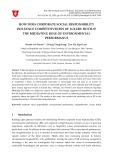
http://www.iaeme.com/IJM/index.asp
137
editor@iaeme.com
International Journal of Management (IJM)
Volume 8, Issue 1, January – February 2017, pp.137–144, Article ID: IJM_08_01_015
Available online at
http://www.iaeme.com/ijm/issues.asp?JType=IJM&VType=8&IType=1
Journal Impact Factor (2016): 8.1920 (Calculated by GISI) www.jifactor.com
ISSN Print: 0976-6502 and ISSN Online: 0976-6510
© IAEME Publication
CORPORATE SOCIAL RESPONSIBILITY AND
EDUCATION SECTOR: ISSUES AND REMEDIES
Dr. Pooja Deshmukh
Associate Professor and Research Coordinator,
MGM Institute of Management, Aurangabad, India
ABSTRACT
Today, education faces the rising challenges of standardized testing, strained budgets, teacher
retention, and global workforce competition. Businesses have begun to take a more targeted
approach in their corporate social responsibility programs and are seeking to impact areas that
have a correlation with their own business goals. For many businesses, education is an important
part of their plans, since the needs exist in all geographic areas, across all subject areas, and for
all kinds of people.
Higher educational institutions in the Marathwada seek to get quality and
talented students. For the perception of higher educational institutions as quality institutions, it is
essential that they behave in a socially responsible manner. Corporate social responsibility (CSR)
is one of the useful tools to positively affect society and develop relationships with stakeholders. So
this paper explains prospects and challenges on both the social and corporate managerial
perspective. This study tries investigates the role of educational institutions to surpass the CSR for
creating best human capital and also explores the significances of CSR for promoting education
and various initiatives of companies in education sector as a corporate responsibility to expansion
education.
Key words: Corporate social responsibility, higher education, issues, strategies
Cite this Article: Dr. Pooja Deshmukh, Corporate Social Responsibility and Education Sector:
Issues and Remedies. International Journal of Management, 8(1), 2017, pp. 137–144.
http://www.iaeme.com/IJM/issues.asp?JType=IJM&VType=8&IType=1
1. INTRODUCTION
Corporate Social Responsibility (CSR) is becoming an increasingly important activity to businesses
nationally and internationally. It ensures the success of a business by the inclusion of social and
environmental considerations into a company’s operations as a positive contribution to society. The
success of a company can be made possible only when the interests of all involved stakeholders are met.
One of the most important stakeholders in this system is the society in which the company operates. Over
the past few decades, there has been an increasing interest and emphasis on the concept of CSR in the
society.
In order to promote economic and industrial development in a country, the essential requirement is the
capacity to develop skilled manpower of good quality in adequate number. According to population
projections based on the 2011 census was released on 31 March 2011 (and was updated on 20 May 2013






























